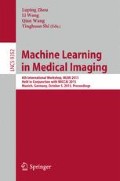Abstract
Random Forest (RF) has been widely used in the learning-based labeling. In RF, each sample is directed from the root to each leaf based on the decisions made in the interior nodes, also called splitting nodes. The splitting nodes assign a testing sample to either left or right child based on the learned splitting function. The final prediction is determined as the average of label probability distributions stored in all arrived leaf nodes. For ambiguous testing samples, which often lie near the splitting boundaries, the conventional splitting function, also referred to as hard split function, tends to make wrong assignments, hence leading to wrong predictions. To overcome this limitation, we propose a novel soft-split random forest (SSRF) framework to improve the reliability of node splitting and finally the accuracy of classification. Specifically, a soft split function is employed to assign a testing sample into both left and right child nodes with their certain probabilities, which can effectively reduce influence of the wrong node assignment on the prediction accuracy. As a result, each testing sample can arrive at multiple leaf nodes, and their respective results can be fused to obtain the final prediction according to the weights accumulated along the path from the root node to each leaf node. Besides, considering the importance of context information, we also adopt a Haar-features based context model to iteratively refine the classification map. We have comprehensively evaluated our method on two public datasets, respectively, for labeling hippocampus in MR images and also labeling three organs in Head & Neck CT images. Compared with the hard-split RF (HSRF), our method achieved a notable improvement in labeling accuracy.
Preview
Unable to display preview. Download preview PDF.
References
Wang, H., et al.: Multi-atlas segmentation with joint label fusion. IEEE Transactions on Pattern Analysis and Machine Intelligence 35(3), 611–623 (2013)
Freund, Y., et al.: A decision-theoretic generalization of on-line learning and an application to boosting. In: Vitányi, P.M. (ed.) EuroCOLT 1995. LNCS, vol. 904. Springer, Heidelberg (1995)
Breiman, L.: Random forests. Machine learning 45(1), 5–32 (2001)
Magnotta, V.A., et al.: Measurement of Brain Structures with Artificial Neural Networks: Two-and Three-dimensional Applications 1. Radiology 211(3), 781–790 (1999)
Zikic, D., Glocker, B., Criminisi, A.: Atlas encoding by randomized forests for efficient label propagation. In: Mori, K., Sakuma, I., Sato, Y., Barillot, C., Navab, N. (eds.) MICCAI 2013, Part III. LNCS, vol. 8151, pp. 66–73. Springer, Heidelberg (2013)
Tu, Z., et al.: Auto-context and its application to high-level vision tasks and 3d brain image segmentation. IEEE Transactions on Pattern Analysis and Machine Intelligence 32(10), 1744–1757 (2010)
Kim, M., et al.: Automatic hippocampus segmentation of 7.0 Tesla MR images by combining multiple atlases and auto-context models. NeuroImage 83, 335–345 (2013)
Fritscher, K.D., et al.: Automatic segmentation of head and neck CT images for radiotherapy treatment planning using multiple atlases, statistical appearance models, and geodesic active contours. Medical Physics 41(5) (2014)
Author information
Authors and Affiliations
Corresponding author
Editor information
Editors and Affiliations
Rights and permissions
Copyright information
© 2015 Springer International Publishing Switzerland
About this paper
Cite this paper
Ma, G., Gao, Y., Wang, L., Wu, L., Shen, D. (2015). Soft-Split Random Forest for Anatomy Labeling. In: Zhou, L., Wang, L., Wang, Q., Shi, Y. (eds) Machine Learning in Medical Imaging. MLMI 2015. Lecture Notes in Computer Science(), vol 9352. Springer, Cham. https://doi.org/10.1007/978-3-319-24888-2_3
Download citation
DOI: https://doi.org/10.1007/978-3-319-24888-2_3
Published:
Publisher Name: Springer, Cham
Print ISBN: 978-3-319-24887-5
Online ISBN: 978-3-319-24888-2
eBook Packages: Computer ScienceComputer Science (R0)

